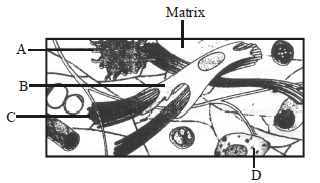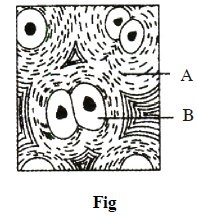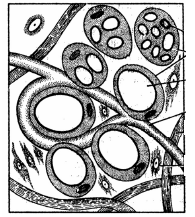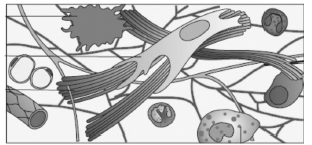Please see Chapter 7 Structural Organisation in Animals Exam Questions Class 11 Biology below. These important questions with solutions have been prepared based on the latest examination guidelines and syllabus issued by CBSE, NCERT, and KVS. We have provided Class 11 Biology Exam Questions and answers for all chapters in your NCERT Book for Class 11 Biology. These solved problems for Structural Organisation in Animals in Class 11 Biology will help you to score more marks in upcoming examinations.
Exam Questions Chapter 7 Structural Organisation in Animals Class 11 Biology
Objective Questions
Question. The ciliated columnar epithelial cells in humans occur in
(a) Eustachian tube and stomach lining
(b) bronchioles and fallopian tubes
(c) bile duct and oesophagus
(d) fallopian tubes and urethra
Answer
B
Question. Epithelial tissue is distinguished from connective tissue, muscular, or nervous tissue by its
(a) large extracellular matrix.
(b) contractibility.
(c) ability to carry action potentials.
(d) basement membrane.
Answer
D
Question. General function of gland is to
(a) protect the body.
(b) control the function of epithelial tissues.
(c) produce and secrete specialized compounds to control and maintain different body functions.
(d) help to maintain blood pressure and nerve actions.
Answer
C
Question. The only type of cell seen in a tendon is
(a) muscle fibres
(b) reticular cells
(c) collagenous cells
(d) fibroblasts
Answer
D
Question. The shape of a person’s ear is mainly due to
(a) dense regular connective tissue
(b) dense irregular connective tissue
(c) elastic cartilage
(d) fibrocartilage
Answer
C
Question. Muscle tissue cells are contractile, which means they
(a) are responsible for the production and secretion of enzymes.
(b) are specialized in contraction and relaxation.
(c) help in the movement of involuntary organs only.
(d) all of the above
Answer
B
Question. Three essential components of most neurons are
(a) simple epithelium, extracellular matrix and nerves.
(b) axon, dendrites and cell body.
(c) nerve cells, synapse and neuroglia.
(d) mylein sheeth, node of Ranvier and Schwann cells.
Answer
B
Question. The fibres of which of the following muscles are fusiform and do not show striations
(a) Skeletal muscles
(b) Cardiac muscles
(c) Both (a) and (b)
(d) Smooth muscles
Answer
D
Question. Smooth muscles are______.
(a) voluntary, branched, uninucleate
(b) voluntary, multinucleate, cylindrical
(c) involuntary, cylindrical, multinucleate
(d) involuntary, spindle shaped, uninucleated, tapering
Answer
D
Question. Which one of the following pairs of structures distinguishe a nerve cell from other types of cell ?
(a) Vacuoles and Fibres
(b) Flagellum and Medullary sheath
(c) Nucleus and Mitochondria
(d) Cell body and Dendrites
Answer
D
Statement Type Questions
Question. Select the correct statement regarding Periplaneta americana
(a) There are 16 very long malpighian tubules present at the junctions of midgut and hindgut.
(b) Grinding of food is carried out only by the mouth parts.
(c) Nervous system is located ventrally and consists of segmentally arranged ganglia joined by a pair of
longitudinal connectives.
(d) Females bear a pair of short thread like anal styles.
Answer
D
Question. Which of the following statement(s) is/are correct regarding compound epithelium ?
(a) It is made of more than one layer of cells and thus has a limited role in secretion and absorption.
(b) Their main function is to provide protection against chemical and mechanical stresses.
(c) They cover the dry surface of the skin, moist surface of buccal cavity, pharynx, inner lining of ducts of salivary glands and pancreatic ducts.
(d) All of the above
Answer
D
Question. Which of the following statements is not correct regarding neural tissue ?
(a) It exerts the greatest control over the body’s responsiveness to changing conditions.
(b) Chondrocytes, the unit of neural system are excitable cells.
(c) Neuroglial cells protect and support neurons.
(d) When a neuron is suitably stimulated, an electrical disturbance is generated.
Answer
B
Question. Which of the following statement(s) regarding cell junctions is/are correct ?
(a) Tight junctions help to stop substances from leaking across a tissue.
(b) Adhering junctions perform cementing to keep neighbouring cells together.
(c) Gap junctions facilitate the cells to communicate with each other by connecting the cytoplasm of adjoining cells, for rapid transfer of ions, small molecules and sometimes big molecules.
(d) All of the above
Answer
D
Question. Read the following statements and answer the question.
(i) It is made of a single thin layer of flattened cells with irregular boundaries.
(ii) They are found in the walls of blood vessels and air sacs of lungs.
(iii) They are involved in functions like forming a diffusion boundary.
Which of the following characteristics of tissue is being described by the above statements ?
(a) Squamous epithelium
(b) Columnar epithelium
(c) Ciliated epithelium
(d) Compound epithelium
Answer
A
Assertion/Reason Type Questions
In the following questions, a statement of Assertion is followed by a statement of Reason.
(a) If both Assertion and Reason are true and the Reason is the correct explanation of the Assertion.
(b) If both Assertion and Reason are true but the Reason is not the correct explanation of the Assertion.
(c) If Assertion is true but Reason is false.
(d) If both Assertion and Reason are false.
Question. Assertion : The squamous epithelium is made of a single thin layer of flattened cells with irregular boundaries.
Reason : They are found in walls of blood vessels and air sacs of wings.
Answer
B
Question. Assertion : Basophils cells secrete histamine.
Reason : Histamine is a vasoconstrictor.
Answer
D
Question. Assertion: In cockroaches the development is paurometabolous.
Reason : Nymph grows by moulting about 13 times to reach the adult form.
Answer
A
Question. Assertion : Cartilage (protein matrix) and bone (calcium matrix) are rigid connective tissue.
Reason : Blood is connective tissue in which plasma is the matrix.
Answer
B
Critical Thinking Type Questions
Question. If the head of cockroach is cut off, it will still be alive for as long as one week. Their is because of
(a) the body which is covered with hard chitinous exoskeleton.
(b) head which holds a bit of nervous system.
(c) head which is of no use.
(d) food capturing appratus which is found elsewhere.
Answer
B
Question. Four healthy people in their twenties faced injuries resulting in damage and death of a few cells given below. Which of the cells are least likely to be replaced by new cells?
(a) Liver cells
(b) Neurons
(c) Malpighian layer of the skin
(d) Osteocytes
Answer
B
Question. What external changes are visible after the last moult of a cockroach nymph?
(a) Development of anal cerci.
(b) Development of both forewings and hind wings.
(c) Development labium.
(d) Mandibles become harder.
Answer
B
Question. Lack of blood supply and presence of the noncellular basement membrane are the characteristics of the
(a) muscular tissue
(b) fluid connective tissue
(c) epithelial tissue
(d) nervous tissue
Answer
C
Question. Cartilage tissues are likely to be slow in healing following an injury because
(a) cartilage cells cannot reproduce.
(b) they lack direct blood supplies.
(c) the intercellular material is missing.
(d) cartilage cells are surrounded by fluids.
Answer
B
Question. Which of the following vertebrate tissues would be an excellent source of collagen?
(a) Liver
(b) Nerve
(c) Muscle
(d) Tendon
Answer
D
Question. The major functions of loose connective tissue include
(a) occupying spaces between organs and supporting epithelia.
(b) supporting and surrounding blood vessels and nerves
(c) cushioning organs, storing lipids and facilitating diffusion.
(d) All of the above
Answer
B
Diagram Type Questions
Question. In the given diagram of areolar connective tissue, the different cells and parts have been marked by alphabets (A, B, C & D). Choose the answer in which these alphabets correctly match with the parts and cells they indicate.

(a) A-Adipocyte, B-Collagen fibres, C-Microfilament, D-Mast cells
(b) A-Macrophage, B-Collagen fibres, C-Microfilament, D-Mast cells
(c) A-Macrophage, B-Collagen fibres, C-Microtubule, D-RBC
(d) A-Macrophage, B-Fibroblast, C-Collagen fibres, D-Mast cells
Answer
D
Question. The intercellular material of the given figure is solid and resists compression. Identify the figure and the label marked as A & B.


Answer
A
Question. The figure given below shows the head region of cockroach. Identify A to F.

(a) A- Compound eye, B-Ocellus, C-Maxilla, DMandible, E-Labrum, F-Labium
(b) A- Ocellus, B-Compound eye, C-Mandible, DMaxilla, E-Labrum, F-Labium
(c) A- Ocellus, B-Compound eye, C-Mandible, DMaxilla, E-Labium, F-Labrum
(d) A- Ocellus, B-Compound eye, C-Maxilla, DMandible, E-Labrum, F-Labium
Answer
B
Question. The given figure shows open circulatory system of cockroach with structure marked as A, B and C. Which structure is a 13 pair of wing shaped involuntary muscles and mantain blood circulation?

(a) A
(b) B
(c) C
(d) Both A nad B
Answer
C
Question. Identify the figure with its correct function.

(a) Areolar connective tissue – Serves as a support framework for epithelium.
(b) Adipose tissue – Store fats and act as heat insulators.
(c) Dense regular tissue – Provide flexibility.
(d) Dense irregular tissue – Provide strength and elasticity.
Answer
B
Question. The given figure shows the nephridial system of earthworm and answer the question.

Select the option which shows the correct identification and the function of the structure marked as “X”.
(a) Lateral heart. It is a blood pumping organ.
(b) Calciferous glands. They neutralize the humic acid present in humus.
(c) Nephridia. It regulates the volume and composition of the body fluids.
(d) Blood glands. They produce blood cells and haemoglobin which is dissolved in blood plasma.
Answer
D
Question. Refer the given figure and identify the correct characteristic feature.

(i) It is a type of loose connective tissue.
(ii) It contains fibroblast, macrophages, collagen fibres and mast cells.
(iii) The cells of this tissue are specialized to store fats.
(iv) The wall of internal organs such as the blood vessels, stomach and intestine contains this type of tissue.
(a) (i) & (ii)
(b) (i) & (iii)
(c) (ii) & (iii)
(d) (iii) & (iv)
Answer
A
Question. Refer the given figure of female reproductive system of cockroach and identify the correct labels (marked as 1, 2, 3 and 4) which are collectively called genital pouch.

(a) 1 & 2
(b) 1 & 3
(c) 2 & 4
(d) 3 & 4
Answer
D